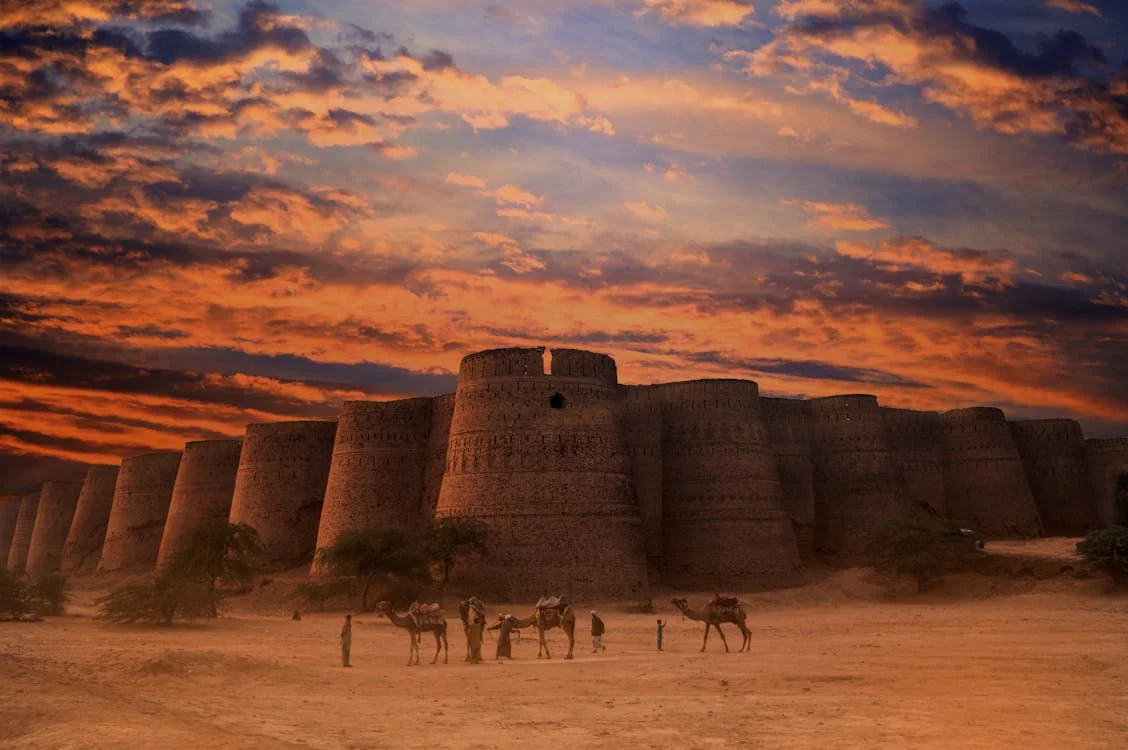Are you searching for a destination that combines breathtaking natural landscapes with rich cultural heritage and warm hospitality? Look no further than Pakistan, one of South Asia’s most underrated travel destinations. This comprehensive Pakistan travel guide will take you through everything you need to know to plan an unforgettable journey through this diverse and fascinating country. From the towering peaks of the Karakoram and Himalayas to the vibrant cultural centers of Lahore and Karachi, Pakistan offers experiences that will captivate even the most seasoned travelers.
Wherever you go becomes a part of you somehow.
Anita Desai
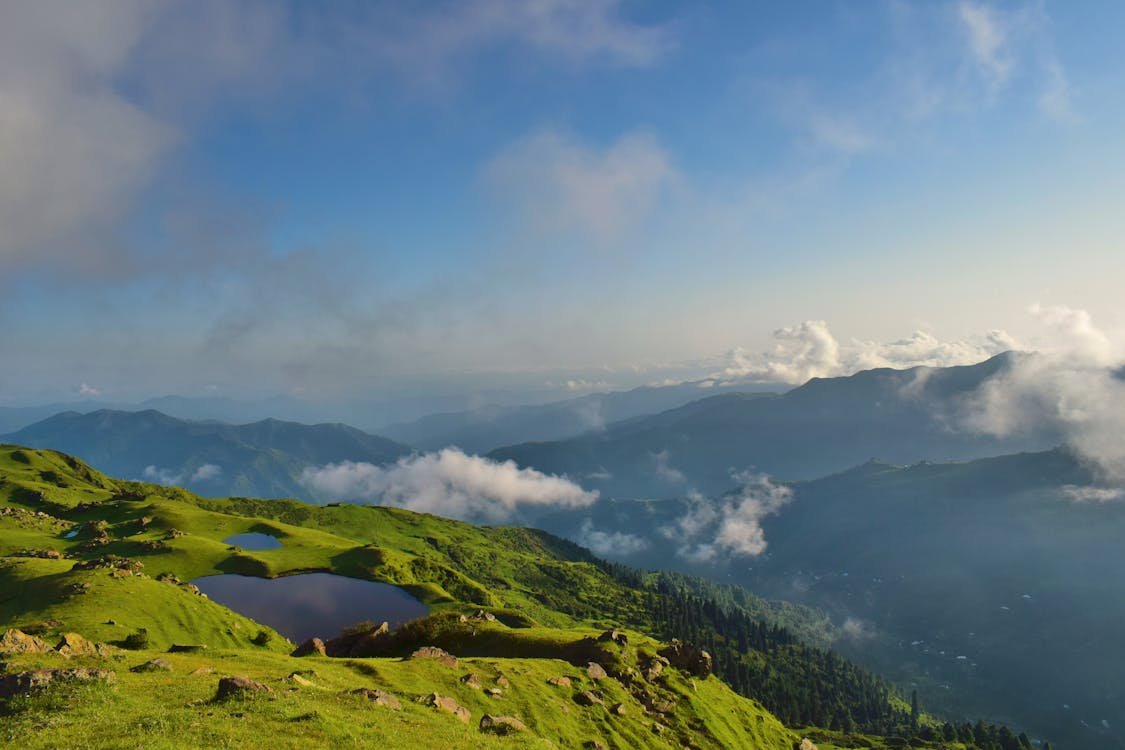
Despite flying under the radar of mainstream tourism, Pakistan has been steadily gaining recognition among adventurous backpackers and travelers seeking authentic experiences. Its strategic location has created a unique cultural tapestry that blends influences from Central, South, and East Asia, resulting in a destination unlike any other. In this guide, we’ll explore the most captivating places to visit in Pakistan while providing practical advice to ensure your journey is as smooth and rewarding as possible.
I. Planning Your Pakistani Adventure: Essential Pre-Trip Preparations
Before you lace up your boots for mountain treks or dive into Lahore’s spice-scented alleys, let’s get the essentials sorted. From weather windows to visa red tape, here’s how to set yourself up for an epic—and smooth—journey through Pakistan.
Determining the Best Time to Visit Pakistan
Timing is crucial when planning your trip to Pakistan, as the climate varies dramatically across different regions. Understanding the best time to visit Pakistan will help you maximize your experience and avoid weather-related complications.

Image: Chitral Valley
When’s the Best Time to Visit Pakistan?
Pakistan is a land of extremes—from snow-capped peaks to sun-drenched deserts—so timing your trip right is key. The country’s diverse geography means the “best time” depends on where you’re headed and what you’re into.
Spring (March–May):
- Pleasant temps + wildflowers in bloom = chef’s kiss for nature lovers.
- This is a great time to explore the northern valleys, when everything from Hunza to Swat comes alive in full color.
Autumn (September–November):
- Dry weather, cool air, golden leaves in the mountains—yes, please!
- Ideal for hiking, road-tripping, and exploring historical cities like Lahore, Taxila, and Multan without the summer scorch.
Summer (June–August):
- Down south? Hot. But up north? Peak adventure season.
- Trek through Gilgit-Baltistan, explore Fairy Meadows, or cross the Karakoram Highway when the snow has cleared and the views are endless.
Winter (December–February):
- Chilly? Yes. Beautiful? Absolutely.
- While some mountain routes close, ski resorts like Malam Jabba open up, and winter festivals give you a deep dive into local traditions.
💡 GOHUB Tip: For most travelers, spring and autumn offer the best mix of scenery, comfort, and fewer crowds. Your photos—and your feet—will thank you.
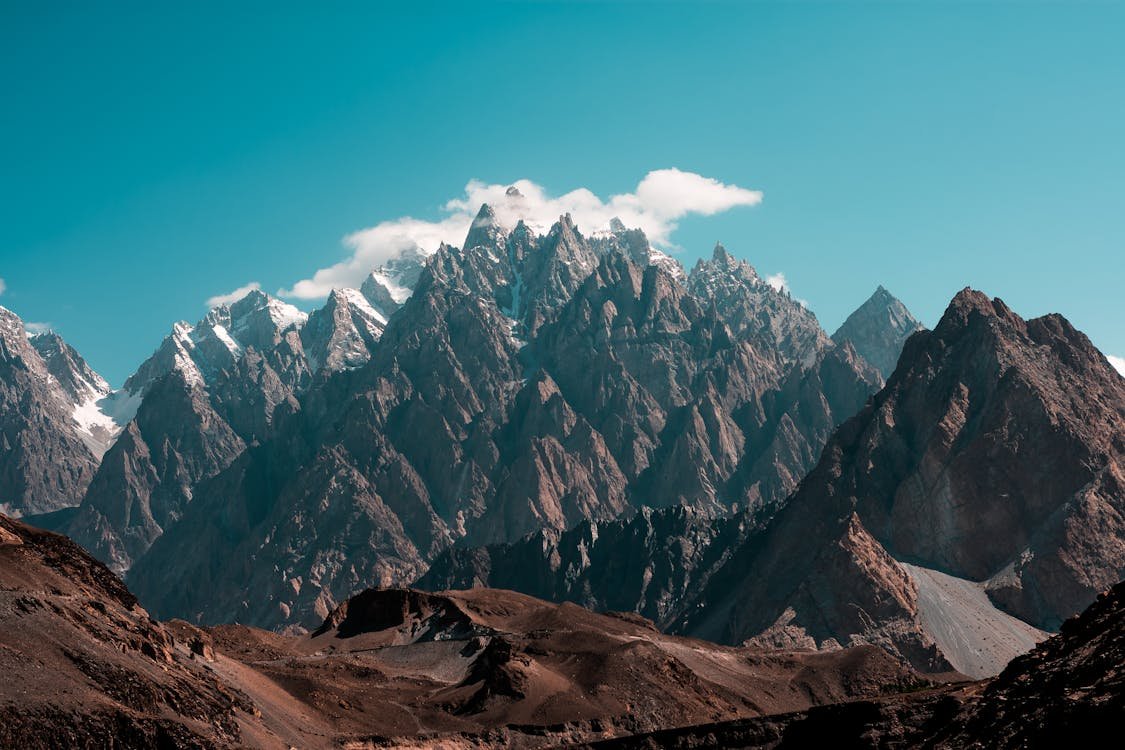
Image: Snow-capped mountains of Karakoram Range
Getting Your Pakistan Visa: Don’t Leave It Last Minute
Getting into Pakistan isn’t difficult, but it does require a little paperwork patience. Most travelers will need a visa—and timing is everything.
Start Here:
Always check the official website of your nearest Pakistani embassy or consulate. Visa policies can (and do) change, so make sure you’re not relying on outdated blogs or hearsay.
What You’ll Likely Need:
- A passport valid for 6+ months
- A rough itinerary or accommodation bookings
- Possibly a letter of invitation (especially for regions like Gilgit-Baltistan)
- Proof of financial means, depending on your nationality
E-Visa System:
Good news—Pakistan now has an e-visa system for many countries. It’s faster, easier, and can often be done from your couch with a cup of chai.
Processing Time:
Can range from a few days to a few weeks. Don’t cut it close—apply at least 3–4 weeks before your trip, just to be safe.
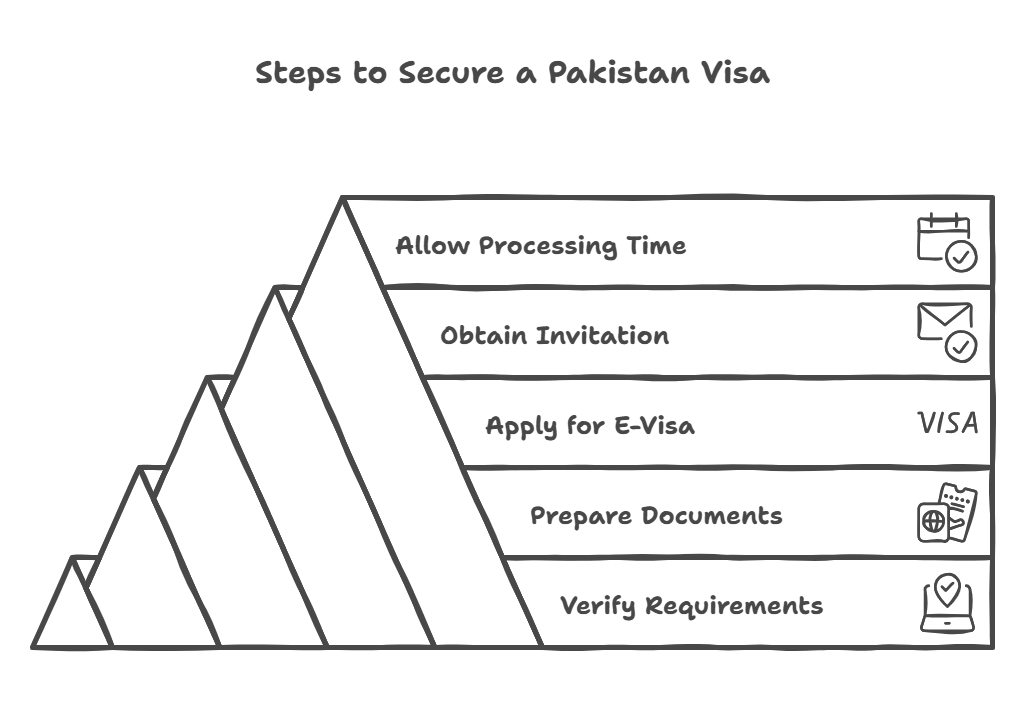
🤔 Need help with an invitation letter or trekking permits? Local tour companies can handle the red tape for you—worth it if you’re heading north or off the beaten path.
II. Budgeting for Your Pakistan Trip
One of the best things about traveling in Pakistan? Your money goes a long way. Compared to most destinations, this is a seriously budget-friendly country—perfect for backpackers and adventurous travelers looking for epic experiences without epic expenses.
But to make the most of it, you’ll want to have a clear picture of where your rupees are going.
Accommodation Costs:
- Backpacker hostels & guesthouses: ~$10–30 USD per night
- Comfortable mid-range hotels: ~$30–80 USD
- Luxury stays (Islamabad, Hunza resorts): ~$100+ per night
Transportation Expenses:
- Domestic flights (e.g. Islamabad to Skardu): ~$50–150
- Long-distance trains: ~$5–20 (economy class)
- Intercity buses: ~$1–5
- Private jeep hire (great for northern trips): ~$50–100 per day with driver
💡 Tip: Sharing a jeep with fellow travelers cuts costs and adds new friends.
Food and Dining:
- treet food & local dhabas: ~$1–5 per meal (cheap and tasty)
- Mid-range cafés or restaurants: ~$5–15
- Fine dining (yes, it exists!): ~$20+
Activities and Entrance Fees:
- Museums & historical sites: $1–10
- Trekking permits: $20–100 depending on the region
- Guided tours or cultural experiences: $20–100 per day
Daily Budget Estimates:
- Backpackers: $30–50/day
- Mid-range travelers: $50–100/day
- Luxury comfort-seekers: $150+/day
📌 Don’t forget extras: visa fees, SIM/eSIM, snacks, tips, or last-minute souvenirs (hello, handmade shawls in Hunza).

Image: Colorful local market in Lahore with traditional crafts and textiles
III. Travel Insurance for Pakistan: Don’t Skip This Part
We know—it’s not the fun part. But if you’re heading into the mountains, taking long bus rides, or planning treks in remote regions, comprehensive travel insurance for Pakistan is a must-have.
You’ll be glad you got it if::
- You twist an ankle on a glacier trail 🥴
- Your flight gets cancelled due to snow
- Your bag takes a detour via a camel (okay, unlikely, but…)
What Should Be Covered?
Medical emergencies + evacuation
- Trip cancellations/delays
- Lost or stolen items
- Adventure activity coverage (check for trekking & climbing inclusions)
- Repatriation
💡 Standard plans often don’t cover trekking over 3,000m or “high-risk” sports—read the fine print and upgrade if needed.
Popular Insurance Providers for Pakistan Travelers
- Heymondo – mobile-first & easy claims process
- World Nomads – flexible plans, great for high-altitude trekking
- SafetyWing – monthly plans, ideal for long-term nomads
🧠 Always double-check your home country’s travel advisories—some insurance plans won’t cover you if there’s a level 4 warning in place.
Documentation:
Keep digital and physical copies of your insurance policy, including the emergency contact numbers. Share this information with a trusted person at home and any tour operators you’re working with in Pakistan.
Several insurance providers offer specialized coverage for adventure travelers visiting Pakistan. Companies like World Nomads, Safety Wing, and Heymondo are popular choices among backpackers for their comprehensive coverage options.
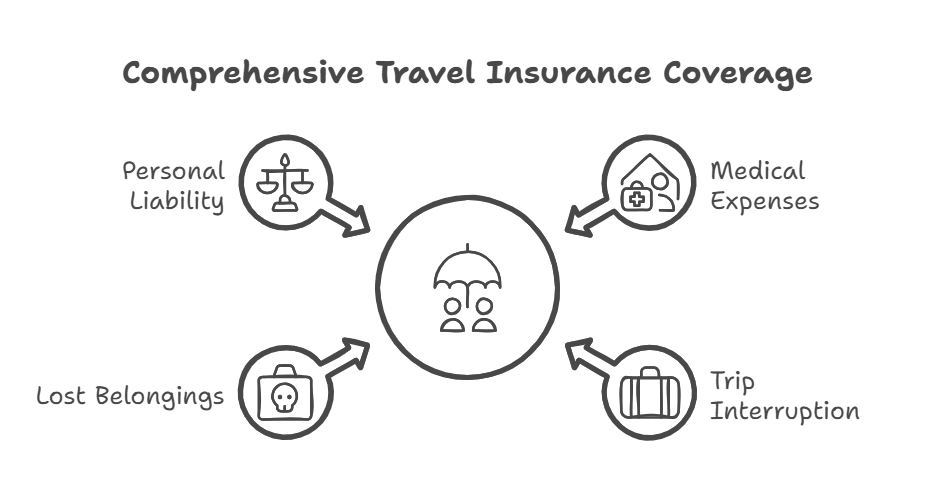
IV. Islamabad: Where Green Meets Grand
If you’re landing in Pakistan for the first time, Islamabad is the perfect place to ease into the adventure. Calm, clean, and cradled by the Margalla Hills, this capital city feels more like a garden town than a buzzing metropolis.
Unlike the chaotic energy of Lahore or Karachi, Islamabad is organized, scenic, and surprisingly peaceful. And while it’s often overlooked in favor of Pakistan’s bigger names, those who spend a day or two here quickly fall for its charm.
What to See in Islamabad
Shah Faisal Mosque is the crown jewel of the city—and one of the most iconic Pakistan tourist attractions. With its tent-like silhouette and stunning mountain backdrop, it’s a peaceful place to visit whether you’re here to admire architecture, snap photos, or simply sit and breathe.
Just up the road, the Pakistan Monument spreads its stone petals wide, symbolizing the unity of the country’s provinces. The small museum beside it is a crash course in national history—perfect if you’re curious about Pakistan’s past before exploring its present.
Lok Virsa Heritage Museum is where Islamabad really shows off its soul. Wander through colorful exhibits of tribal art, handmade textiles, musical instruments, and cultural gems from every corner of the country. It’s like a mini Pakistan under one roof.
Key Islamabad attractions include:
Shah Faisal Mosque: This architectural marvel is one of the largest mosques in the world, with a design inspired by Bedouin tents. Its unique style, massive prayer hall, and beautiful location against the backdrop of the Margalla Hills make it one of the most impressive Pakistan tourist attractions.
Pakistan Monument: This relatively modern landmark represents the four provinces and three territories of Pakistan through its petal-shaped structure. The adjacent museum offers insights into Pakistan’s history and struggle for independence.
Lok Virsa Heritage Museum: For cultural enthusiasts, this ethnological museum showcases Pakistan’s diverse cultural heritage through exhibits of traditional crafts, musical instruments, and folk art from various regions.
Daman-e-Koh: This viewpoint in the Margalla Hills offers panoramic vistas of Islamabad and neighboring Rawalpindi. It’s particularly beautiful at sunset and provides excellent photography opportunities.
Rawal Lake: A serene spot for relaxation and outdoor activities, this artificial reservoir offers boating opportunities and peaceful walking paths.
From Islamabad, you can easily arrange transportation to nearby historical sites like Taxila, an important archaeological site and early center of Buddhism, making the capital an excellent starting point for your Pakistani adventure.
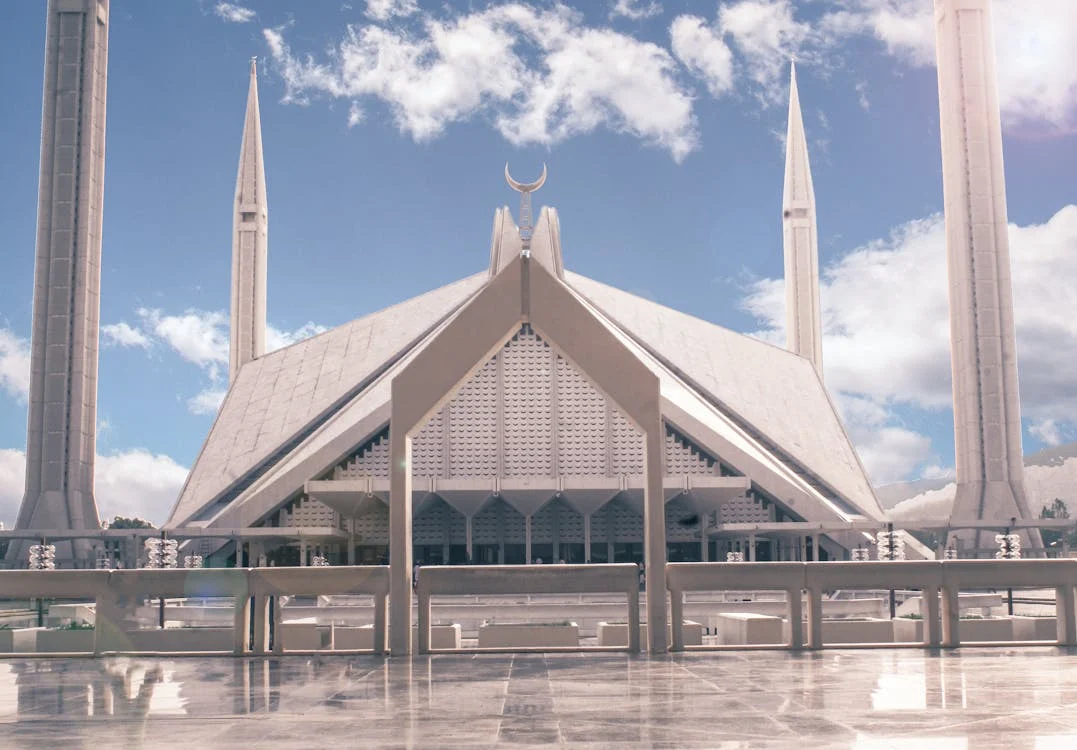
Image: Shah Faisal Mosque with its distinctive architecture against blue sky
V. Lahore: Where Culture, History & Curry Collide
If Pakistan had a beating cultural heart, it would be Lahore—loud, poetic, deeply historic, and absolutely delicious.
No serious Pakistan travel guide skips this city, and for good reason. It’s where ancient Mughal grandeur meets street art and chai dhabas. Where you can get lost in a bazaar by day and dance to Sufi music by night. Lahore isn’t just a place—it’s a whole experience.
Mughal Majesty: Forts, Gardens & Mosques
Step into the Lahore Fort and you’re entering centuries of royal history. Towering gates, marble halls, whispering courtyards—it’s like Game of Thrones, but real (and warmer). Right next door, the Badshahi Mosque rises like a sandstone crown against the sky. One of the largest mosques in the world, it’s equally humbling whether you’re admiring the arches or just soaking in the silence.
And then there’s the Shalimar Gardens—a UNESCO-listed oasis of fountains and floral symmetry, perfect for a lazy stroll or a poetic moment (Lahore inspires that).
The Walled City: Lahore in Full Color
For the real Lahore, wander into the Walled City. Start at Delhi Gate, where the past seeps out of every brick. Here, the alleys twist through spice markets, rooftop tandoors, hidden shrines, and some of the best street food in Pakistan.
It’s a place of contradictions: motorbikes zoom past wooden balconies from the 1600s, and neon signs blink above centuries-old mosques. But that’s Lahore—a living museum that refuses to stay quiet.
Museums & Miniatures
Need a culture breather indoors? The Lahore Museum is packed with Gandharan Buddha statues, Mughal weapons, miniature paintings, and ancient manuscripts. You’ll come out smarter (and likely a little overwhelmed—in a good way).
Food That Makes You Forget Everything Else
If you came to Lahore and didn’t eat until you couldn’t walk—did you even come?
Start your day with nihari (a slow-cooked, spiced meat stew), snack on butter chicken, seekh kebabs, or haleem, and wrap it up at Food Street under fairy lights with a view of the Badshahi Mosque.
💡 Gohub Tip: Ask a local to take you on a “food crawl.” You’ll taste dishes you can’t pronounce—and probably never forget.
Why Lahore is Perfect for First-Timers
With better roads, clear signage, and a vibrant hospitality scene, Lahore is one of the most accessible cities in Pakistan for international visitors. Whether you’re into history, culture, photography, or just food—Lahore says “welcome,” and means it.

Image: Badshahi Mosque’s grand courtyard with red sandstone architecture
VI. The Northern Gems of Pakistan: Welcome to Gilgit-Baltistan
If there’s one place that turns travelers into storytellers—it’s Gilgit-Baltistan. Home to some of the world’s highest peaks, turquoise lakes, and ancient kingdoms, this mountainous region isn’t just scenic—it’s straight-up otherworldly.
For many, this is the highlight of their Pakistan adventure. It’s wild, vast, deeply soulful—and 100% unforgettable.
Hunza Valley: Where Beauty Feels Unreal
Often called “paradise on Earth”, Hunza is exactly that. With ancient forts perched on cliffs, snow-dusted giants looming on all sides, and apricot blossoms painting the valleys pink in spring—it’s hard not to fall in love.
- Baltit Fort: A 700-year-old time capsule where Tibetan and local architecture meet—and the mountain views from the rooftop are next-level.
- Eagle’s Nest Viewpoint: Perfect for sunrise or sunset—bring tea and watch the valley light up like a dream.
- Attabad Lake: Born from tragedy (a landslide in 2010), but now one of Pakistan’s most Instagrammed spots. Bright blue water + boat rides = magic.
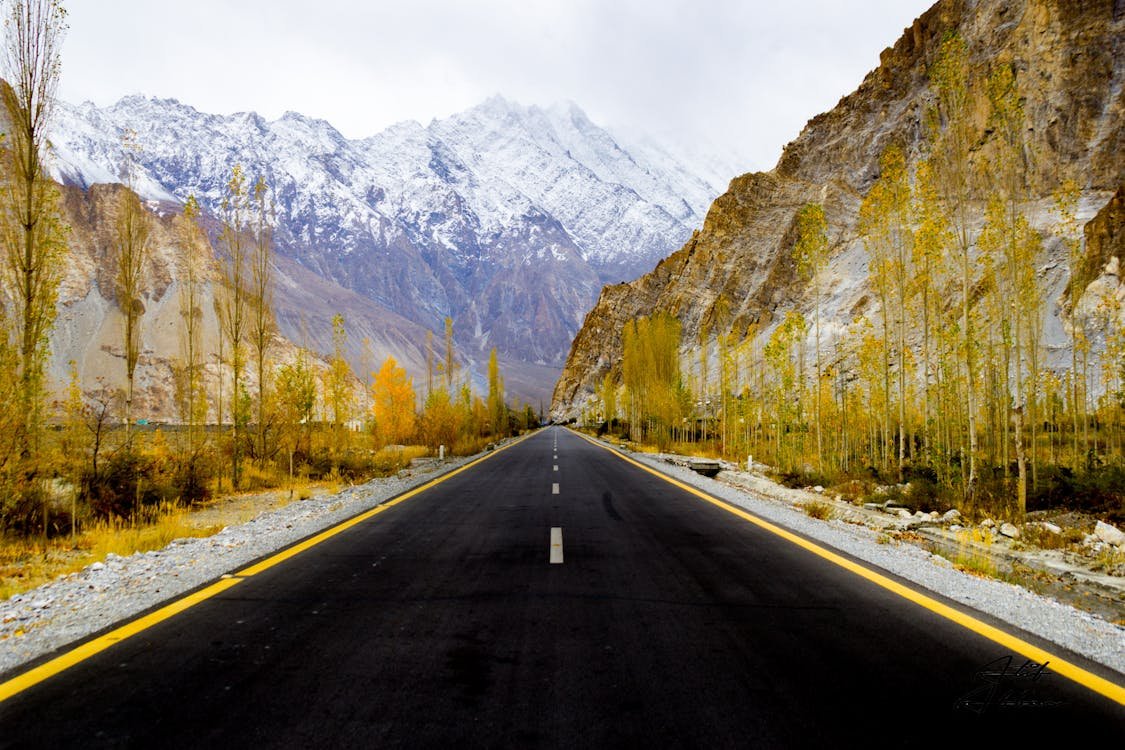
Image: Hunza Nagar
Skardu & Shigar: Basecamps for the Bold
These towns are more than just stopovers—they’re the gateway to some of Earth’s most dramatic landscapes, including K2.
- Shangrila Resort (Lower Kachura Lake): A slice of alpine fantasy. Think mirror lakes, red-roofed chalets, and a surreal sense of peace.
- Shigar Fort: A 400-year-old palace turned heritage hotel where you can sleep like a Balti prince.
- Deosai Plains: Called the “Land of Giants,” this high-altitude plateau (4,114m) stretches endlessly with wildflowers, streams, and grazing yaks. In summer, it feels like nature’s cathedral.
Fairy Meadows: Where Legends Touch the Sky
The name isn’t an exaggeration—Fairy Meadows is a real-life fairytale spot nestled at the foot of Nanga Parbat (the world’s 9th highest peak).
Getting there is half the adventure: a bumpy jeep ride, followed by a trek or horseback climb. But when you wake up in a wooden hut with that mountain staring you in the face… you’ll get it.
💡 GOHUB Tip: Pack warm layers—even in summer. Nights in the north can be freezing, and the stars? Absolutely worth braving the cold for.
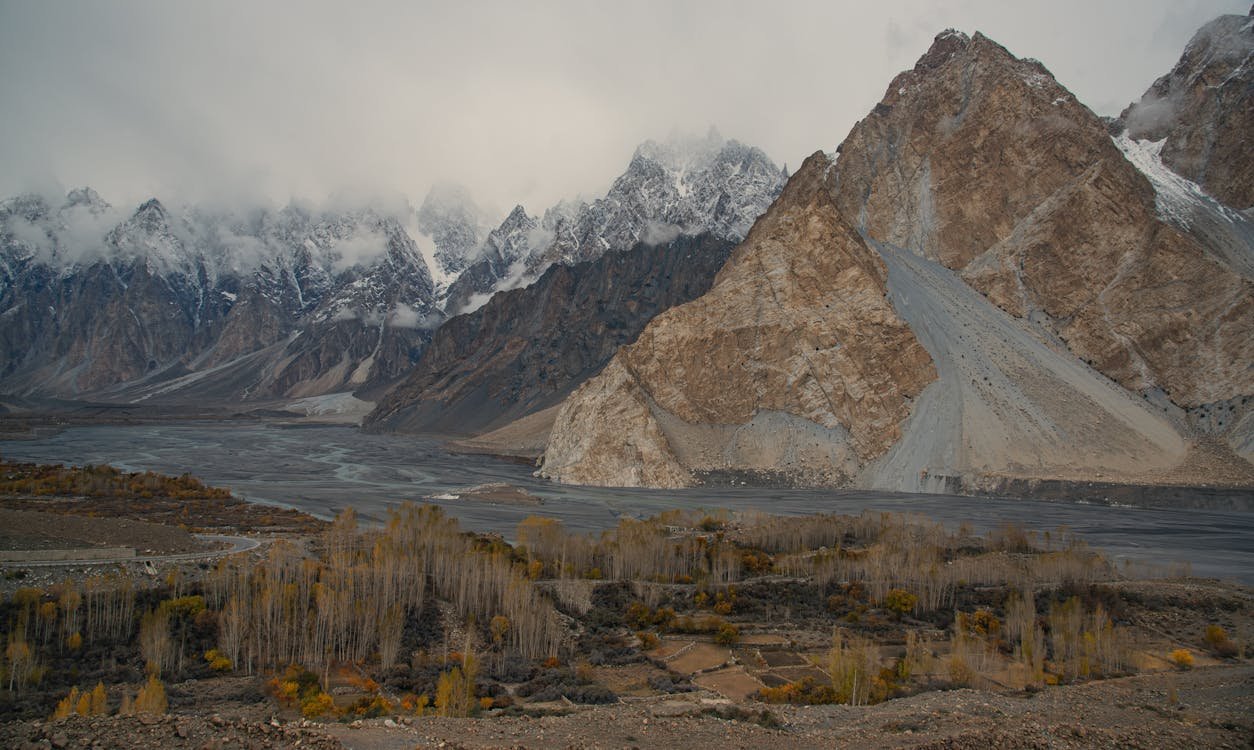
Image: Hunza Valley with snow-capped mountains
A Note on Logistics
Traveling through Gilgit-Baltistan takes a little more planning—roads can be rough, permits may be needed (especially if you’re trekking near borders), and weather delays happen.
But the tradeoff? Jaw-dropping views, rich culture, and raw adventure—the kind that sticks with you long after the trip ends.
Other Notable Pakistan Destinations: Off the Tourist Radar, But So Worth It
While the north gets most of the love (we get it—those mountains are irresistible), Pakistan is packed with hidden corners and cultural gems that deserve a spot on your itinerary.
If you’re the kind of traveler who loves to go beyond the highlights, these destinations will take your Pakistan adventure to the next level.
Swat Valley: Forests, Legends & a New Beginning
Often called the “Switzerland of Pakistan”, Swat Valley is a lush, green escape in Khyber Pakhtunkhwa that’s finally reclaiming its place on the traveler map. Once a spiritual hub of the Gandharan Buddhist world, now it’s a peaceful haven for hikers, historians, and lovers of alpine views.
Expect rivers that sparkle, pine forests that smell like magic, and friendly locals who are proud to see tourism return.
Kalash Valleys: A Culture Frozen in Time
Tucked into the Chitral region, the Kalash Valleys are like nowhere else in Pakistan. The Kalash people, known for their pre-Islamic traditions, vibrant festivals, and colorful attire, offer a rare glimpse into a unique mountain culture.
Visit during one of their seasonal celebrations—like Joshi (spring) or Chilimjusht (harvest)—and you’ll find music, dancing, and storytelling that feels timeless.
💡 Cultural travel in Pakistan doesn’t get more immersive than this.
Kaghan Valley: Lakes, Legends & Snowy Peaks
In the Mansehra District, Kaghan Valley is a photographer’s dream and a poet’s playground. Think winding roads, dramatic scenery, and lakes that look like they were edited in Photoshop.
- Lake Saif ul Malook: A sparkling alpine lake surrounded by snowcaps—famous for both its beauty and local love stories.
- Lulusar Lake: Quieter, higher, and perfectly mirrored—great for a peaceful escape into the clouds.
Karachi: The Ocean-Side Metropolis
Often skipped in favor of the north, Karachi is Pakistan’s biggest city—and it has a rhythm all its own. It’s bold, busy, and bursting with beaches, colonial buildings, Sufi shrines, and food that’ll leave you speechless (and spicy).
Highlights include:
- Clifton Beach at sunset
- Mohatta Palace for art & history
- Saddar Bazaar for the kind of shopping that always turns into a story
It’s loud, layered, and full of life. If you want to understand modern Pakistan—you have to meet Karachi.
Each of these places shows just how diverse and unexpected Pakistan travel destinations can be. Whether you’re drawn to mountain myths, coastal cities, or remote cultures—there’s always something beyond the guidebook waiting to surprise you.

Image: Crystal clear waters of Lake Saif ul Malook with mountain reflections
🏔️ Exploring South Asia? Check out Bhutan’s hidden travel gems — perfect for pairing with your Pakistan trip if you’re chasing meaning and mountains.
VII. Immersing in Pakistani Culture: Experiences and Etiquette
Traveling to Pakistan isn’t just about visiting beautiful places—it’s about meeting the people who bring those places to life. From the fragrant chai offered by a stranger to the rhythmic beat of a Sufi drum echoing under starlit skies, Pakistani culture invites you to not just observe, but truly participate.
It’s in these everyday moments—sitting on a woven mat, sharing bread, being pulled into a wedding dance—you begin to understand what makes this country unforgettable.
This section will guide you through the most enriching cultural experiences in Pakistan, along with the essential etiquette tips to help you engage respectfully and meaningfully with the communities you encounter.
Embracing Pakistani Culture: Heart, Hospitality & How to Connect
You might come to Pakistan for the mountains or the history—but you’ll stay in love with it because of the people.
If there’s one thing travelers never forget, it’s the hospitality of Pakistani culture. Strangers become hosts, chai becomes conversation, and before you know it, you’re being invited to a wedding by someone you met on a bus.
To truly understand the soul of this country, immersing yourself in cultural experiences is key—and trust us, Pakistan will welcome you in with open arms (and probably snacks).
Chai Culture: Small Cups, Big Conversations
Tea, or chai, isn’t just a drink here—it’s a daily ritual. Whether you’re in a city café or sitting cross-legged on a roadside charpai (rope bed), a cup of chai is an invitation to slow down and connect.
Accept it. Sip slowly. You’re not just having tea—you’re sharing stories, laughter, and a slice of everyday life.
Handicrafts & Traditions That Tell Stories
Pakistan’s artistic heritage runs deep—from the mirror embroidery of Sindh to the woodwork of Chiniot and Kashmiri carpets woven with centuries of symbolism.
Visiting artisan workshops or local bazaars isn’t just about buying souvenirs—it’s about witnessing traditions passed down through generations, often by hand and heart.
Music & Mysticism
Whether it’s the hypnotic rhythms of a qawwali performance in Lahore or the sound of a lone rubab in the north, music in Pakistan is deeply spiritual, regional, and powerful.
If you get the chance to attend a Sufi music night or catch live folk dance during a festival—go. Even if you don’t understand the words, you’ll feel it.
Festivals, Weddings & Everyday Joy
If your visit lines up with Eid, Basant, a local Urs, or—if you’re lucky—a wedding invitation, say yes.
Pakistani celebrations are a joyful mix of food, color, music, and generous chaos. You might not know the customs, but locals will love that you’re part of the moment.
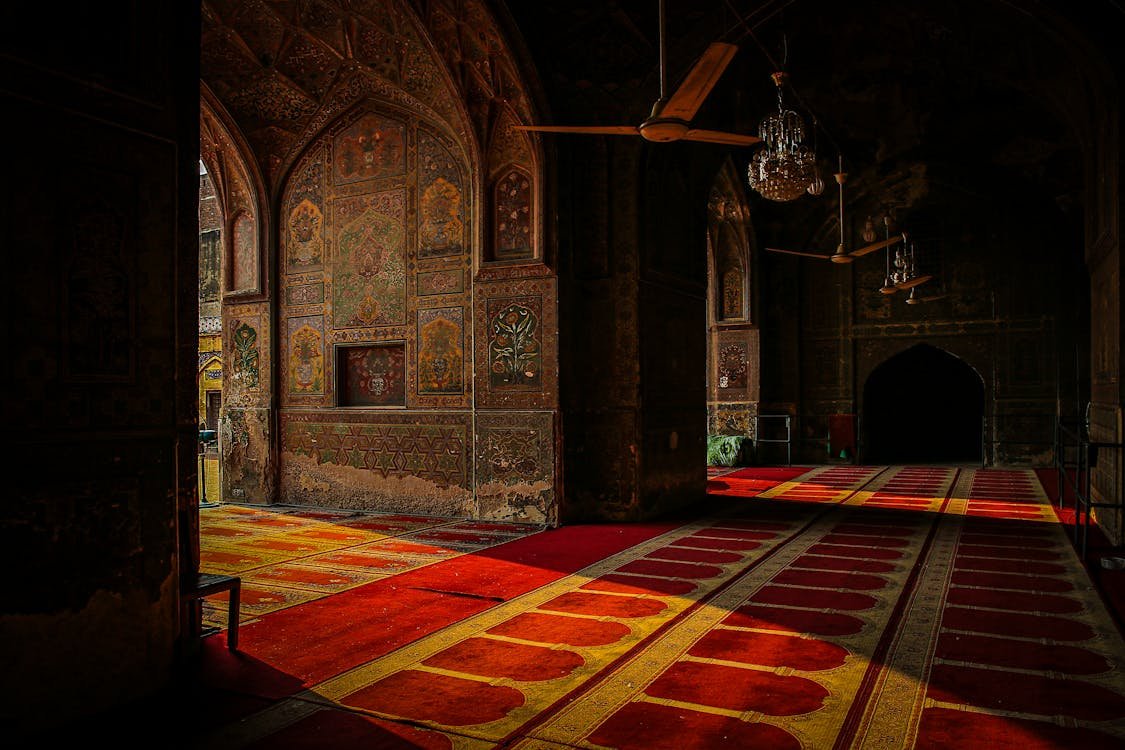
Image: Badshahi Mosque
Cultural Etiquette: A Few Things to Keep in Mind
To fully appreciate Pakistani culture, a little awareness goes a long way. Here’s how to show respect and travel thoughtfully:
Greetings matter: A warm “Assalamu alaikum” (peace be upon you) goes a long way. A smile, a slight head nod, and a few words in Urdu or a local dialect? That’s how you open doors.
Dress modestly: Long sleeves, covered knees, and loose clothing are appreciated—especially at religious sites or in rural areas. Women may want to carry a scarf for mosques or more conservative areas.
Respect Ramadan: If you’re visiting during the holy month, avoid eating or drinking in public during the day. Even a small gesture of understanding is valued.
Photography with care: Always ask before photographing people—especially women and elders. When in doubt, check with your local guide.
When You Respect, You’re Welcomed Like Family
Approach every encounter with openness and curiosity, and Pakistan will respond with a kind of generosity that’s hard to describe.
It’s not just about what you’ll see or do—it’s about how you’ll feel: welcomed, valued, and, somehow, right at home.
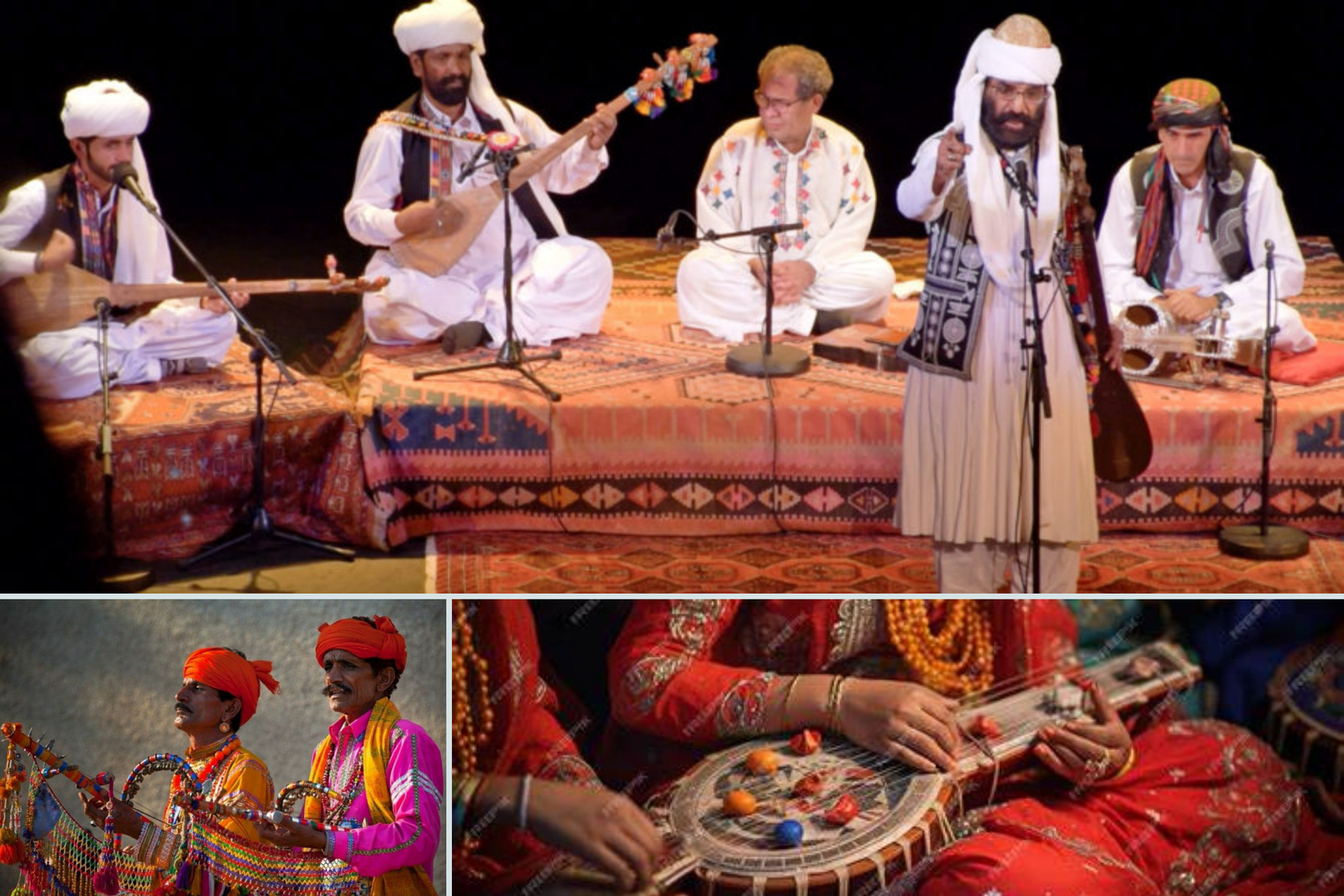
Image: Traditional Pakistani music performance with local instruments
VIII. Exploring Pakistani Cuisine: A Full-Flavored Adventure
If you want to understand Pakistan, start with a plate. Or ten.
From sizzling kebabs in Peshawar to buttery biryani in Karachi, Pakistani cuisine is as rich and diverse as the landscapes it comes from. It’s not just food—it’s identity, family, celebration, and survival. And trust us: you won’t go hungry here.
A Taste of the Regions
Each part of the country brings something delicious to the table—literally.
Punjab is the land of big flavors and even bigger portions. Dishes like nihari, butter chicken, and haleem will warm you from the inside out. And don’t even get us started on the breads—naan, roti, paratha—fluffy, flaky, always fresh from the tandoor.
Sindh, especially Karachi, turns up the heat with spicier, tangier flavors. The legendary Karachi biryani is a fiery, fragrant rice dish layered with marinated meat and spice blends you’ll dream about long after you’ve gone.
Khyber Pakhtunkhwa offers hearty, meat-forward dishes built for mountain strength. Try chapli kebab, namkeen gosht, or a sizzling Peshawari karahi—simple ingredients, bold taste, and zero compromise.
Gilgit-Baltistan surprises with dishes made for altitude and warmth: apricot soups, walnut stews, and home-cooked meals served with yak butter tea. It’s the kind of food that tells a story, especially on a cold mountain night.
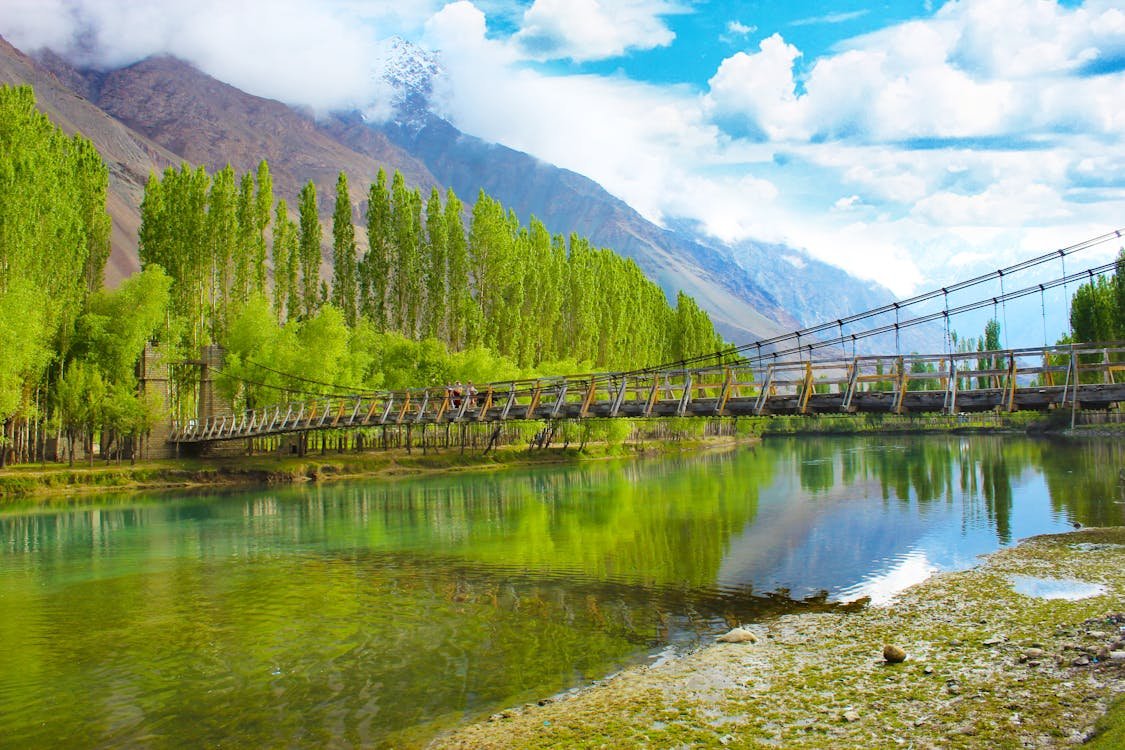
Image: Gilgit-Baltistan
Where to Eat: From Street Corners to Starched Linens
Some of the best food in Pakistan doesn’t come with a menu.
- Fine dining in cities like Lahore, Karachi, and Islamabad puts a modern spin on traditional flavors. Think beef nihari with truffle oil or deconstructed kebabs on microgreens. Fancy, but still very Pakistani.
- Street food is king. Think gol gappay (spicy, crunchy water bombs), samosas, and chaat bursting with flavor. Look for the busiest stalls—that’s usually where the magic happens.
- Dhabas (roadside diners) are where you’ll find honest, home-style food, especially if you’re road-tripping through the countryside. Sit on a woven charpai, sip some chai, and dig in.
Food Safety Tips (Without Killing the Vibe)
Eating your way across Pakistan is half the fun—just stay a little smart:
- Stick to freshly cooked, hot meals
- Peel fruits yourself; skip raw veggies from street carts
- Always go for bottled or filtered water
- Consider bringing probiotics or rehydration salts if your stomach’s shy
💡 GOHUB Tip: When in doubt, eat where locals eat—and don’t be afraid to ask for “less spicy” if you’re not chili-trained 🔥
More Than Just Meals
Pakistani food isn’t just about taste—it’s about belonging.
You’ll be offered a plate before you’re asked your name. You’ll share naan with strangers who instantly feel like family. And you’ll leave with more than full stomachs—you’ll carry flavors, stories, and maybe even a recipe or two.
So yes, come for the mountains. But don’t leave without licking your fingers at least once.

Image: Street food in Pakistan
IX. Practical Pakistan Travel Tips for a Smooth Journey
You’ve mapped out your dream destinations and drooled over the food—but let’s talk logistics. Because in a place as wild and wonderful as Pakistan, a little preparation goes a long way.
From staying connected in the remote north to understanding local transport quirks and safety know-how, these Pakistan travel tips will help you dodge common hiccups and focus on what matters: enjoying the ride.
Let’s get your trip running smoother than a fresh roti off the tandoor
Staying Connected in Pakistan: Easy, Smart, and Essential
Let’s be real—having internet on the road in Pakistan is a game-changer. Whether you’re navigating the twisting alleys of Lahore, translating signs in the bazaar, or just checking if that chai dhaba in Hunza is open, a reliable data connection makes everything smoother.
Local SIM Cards: The Traditional Route
Buying a local SIM card when you land is one option. Major networks like Jazz, Zong, Telenor, and Ufone offer good coverage in most cities and tourist hubs.
- You’ll need your passport for registration
- SIMs are available at airports and mobile shops
- Plans are generally affordable and include data + call time
📌 BUT if you’re heading to remote areas like Fairy Meadows or Deosai, coverage might vanish. Best to check coverage maps beforehand or ask your guesthouse.
Gohub eSIM: Instant Internet, Zero Hassle
Want to skip the SIM queue and land with data already working?
That’s where Gohub’s Pakistan eSIM comes in:
- Instant activation – set it up before you fly
- No roaming fees – just reliable 4G across cities and major travel routes
- Perfect for maps, messaging, and emergency use
- No physical SIM swapping, no language barrier, no hunting for kiosks at 2AM
💡 GOHUB Tip: Use the eSIM for primary data, and pick up a cheap local SIM only if you need local calls or extended coverage up north.
Bonus: Offline Prep = Smart Travel
Even with great service, there’ll be moments when you’re off-grid (and that’s part of the charm!). So before you head into the mountains or deep rural zones:
- Download offline maps on Google Maps or Maps.me
- Save key phrases or menus in Google Translate
- Keep important info screenshotted or stored in your phone notes
With the right prep, staying connected in Pakistan is easy, affordable, and helps you get the most out of every moment—without getting lost in the bazaar or ghosted by Google Maps mid-trek 😄
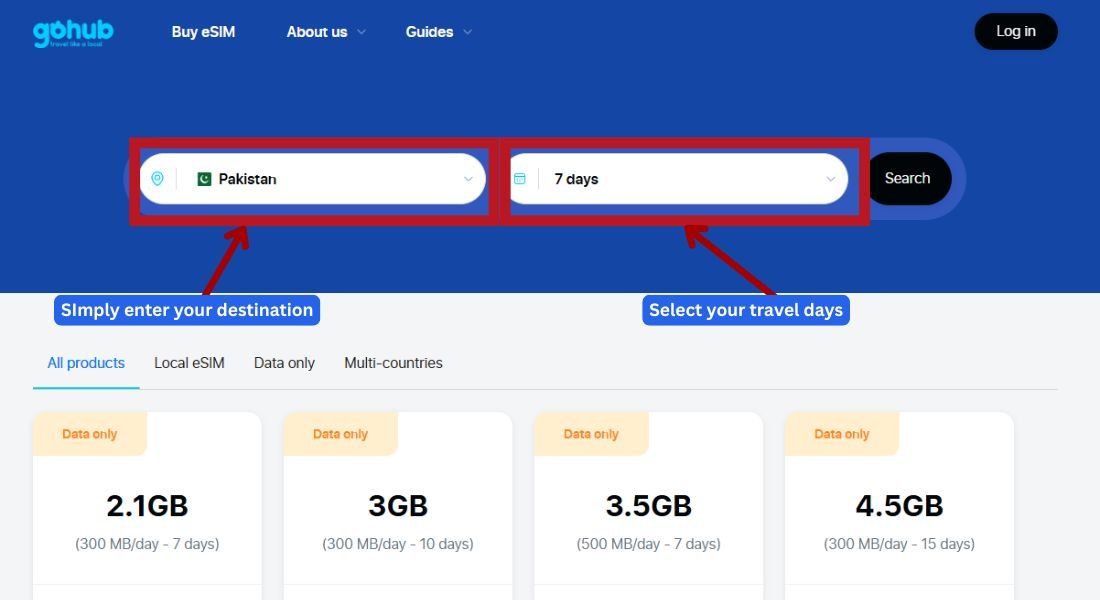
Image: Screenshot of the GoHub eSIM webpage, highlighting the destination input field with “Pakistan” selected, illustrating how users can easily search for eSIM data plans.
Money Matters: Currency and Payments
Let’s talk rupees, receipts, and reality—because managing your money wisely is key to enjoying your trip without unexpected surprises.

Image: The Pakistani Rupee (PKR)
Currency: Know Your Rupees
The local currency is the Pakistani Rupee (PKR). Notes come in a rainbow of colors and values, but they can feel a bit confusing at first. Pro tip: get familiar with the current exchange rate before you arrive, and screenshot a conversion app—you’ll use it often at markets and guesthouses.
Cash Is (Still) King
While big hotels and some restaurants in cities accept credit cards, most of Pakistan still runs on cash—especially in rural areas and smaller towns.
Always carry enough rupees for a few days when you’re heading off the beaten path. Even in scenic touristy regions like Hunza or Skardu, card machines are rare and internet for payment apps is not always reliable
💡 GOHUB Tip: Break large notes early (like at gas stations or grocery stores), because small shops and taxis often can’t make change..
ATMs in Pakistan: Helpful, But Not Everywhere
In major cities like Islamabad, Lahore, and Karachi, you’ll find plenty of ATMs—especially from big banks like HBL, UBL, Standard Chartered, and MCB. Most accept international cards (Visa and Mastercard), though not all machines work 24/7 or have English menus.
- Inform your bank before your trip to avoid card blocks
- Always have a backup card or emergency cash
- Expect limited or no ATMs in remote regions like Fairy Meadows, Deosai, or Kalash
Money Exchange: Where to Do It
The most reliable places to exchange foreign currency are:
- Airport exchange counters (slightly lower rates, but convenient)
- Licensed money changers in city centers (better rates)
- Avoid changing money on the street unless recommended by locals or your hotel
If you’re coming from Southeast Asia or Europe, US dollars and British pounds are easiest to exchange. Euros are accepted too, but might get less favorable rates.
By being cash-savvy and planning ahead, you’ll avoid unnecessary ATM stress and be ready to grab that roadside kebab, buy a handwoven rug—or tip your guide for an unforgettable mountain trek.
📶 From Lahore’s bustling bazaars to the Hunza Valley, Gohub’s Asia eSIM gives you seamless data across Pakistan and beyond — instant setup, prepaid, and no roaming fees.


